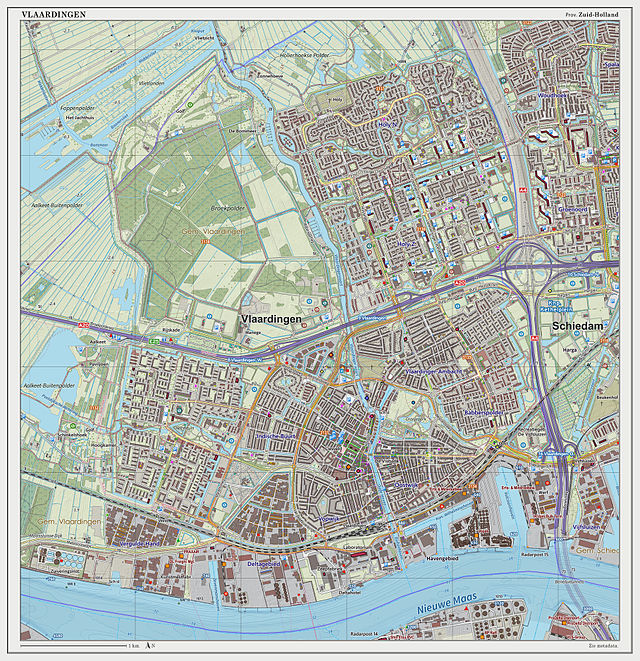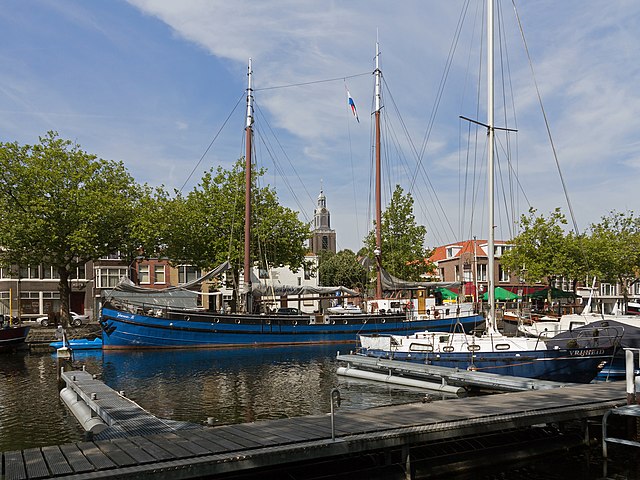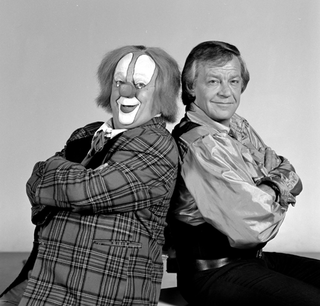Vlaardingen
Town and municipality in South Holland, Netherlands From Wikipedia, the free encyclopedia
Town and municipality in South Holland, Netherlands From Wikipedia, the free encyclopedia
Vlaardingen (Dutch pronunciation: [ˈvlaːrdɪŋə(n)] ) is a large town and municipality in South Holland in the Netherlands. It is located on the north bank of the Nieuwe Maas river at the confluence with the Oude Maas. The municipality administers an area of 26.69 km2 (10.31 sq mi), of which 23.57 km2 (9.10 sq mi) is land, with 73,924 residents in 2021.
Vlaardingen | |
|---|---|
Town and municipality | |
 Old harbour in the centre of Vlaardingen | |
| Nickname: Haringstad (Herring town) | |
 Location in South Holland | |
| Coordinates: 51°54′N 4°21′E | |
| Country | Netherlands |
| Province | South Holland |
| Government | |
| • Body | Municipal council |
| • Mayor | Bert Wijbenga (VVD) |
| Area | |
| • Total | 26.69 km2 (10.31 sq mi) |
| • Land | 23.57 km2 (9.10 sq mi) |
| • Water | 3.12 km2 (1.20 sq mi) |
| Elevation | 1 m (3 ft) |
| Population (January 2021)[4] | |
| • Total | 73,924 |
| • Density | 3,136/km2 (8,120/sq mi) |
| Demonym | Vlaardinger |
| Time zone | UTC+1 (CET) |
| • Summer (DST) | UTC+2 (CEST) |
| Postcode | 3130–3138 |
| Area code | 010 |
| Website | www |



The town is divided into a northern part (locally known as the "Holy") and a southern part by the A20 motorway. On the east the town is separated from Schiedam by the A4 motorway. Other places nearby are the small town Maassluis to the west, the village Schipluiden and the city Delft to the north, the town Schiedam and city Rotterdam to the east and the town of Spijkenisse in the south-west, on the other side of the river Nieuwe Maas. The A20 connects Rotterdam to the village Hook of Holland. The Beneluxtunnel (the tunnel that runs under the Nieuwe Waterweg) connects the A20 to the A15.
The centre of the town is on the west side of the old harbour, which was originally a stream ('De Vlaarding') from the peat lands north and east of the town, running to the Meuse estuary.
The area around Vlaardingen was already settled by about 2900 to 2600 BC. In 1990, a skeleton dated around 1300 BC was dug up in the edge of Vlaardingen. Some human nuclear DNA was identified, the oldest found anywhere in the Netherlands. In Roman times a stronghold or vicus named Flenio may have been on the site of modern Vlaardingen.[5] Between roughly 250 AD and 700 AD the region seems to have been uninhabited, like much of the west of the Netherlands. In 726 or 727 the area is again mentioned as In Pagio Marsum, where a small church was established, around which Vlaardingen formed. The church is mentioned on a list of churches Willibrord, the Apostle to the Frisians, inhered to the Abbey of Echternach.
In 1018, Vlaardingen was a stronghold of Dirk III, who levied an illegal toll on ships on the Meuse river. An army sent by German Emperor Henry II to stop this practice was defeated by Dirk III in the (First) Battle of Vlaardingen. In 1047, his successor Dirk IV repelled another such attack (Second Battle of Vlaardingen). The first of these battles was commemorated in 2018 by a historical reenactment
A flood disaster of December 21, 1163 (Saint Thomas Flood), ended the growth of Vlaardingen. The Counts of Holland moved away and its development stagnated.
In 1273, Vlaardingen was granted town privileges by Floris V, Count of Holland. Older town privileges are possible, but not provable.
In 1574, during the Eighty Years War of Dutch independence, a group of Watergeuzen burnt down Vlaardingen as commanded by William of Orange to prevent the Spanish from capturing the town. Vlaardingen later became a shipbuilding area and a significant harbour for the herring fishing industry. The fishing boats (originally "haringbuizen", later also "sloepen" and "loggers") ceased to use Vlaardingen in the years after World War II.
In 1855, the former municipality of Zouteveen was merged into the municipality Vlaardingerambacht which in turn was merged with Vlaardingen in 1941 during the German occupation of the Netherlands.
Because of industrialization in and close to Vlaardingen, the town suffered from heavy air pollution and, sometimes, pathogenic smog during the 1970s. One day, a high school had to be closed because of the smog. Many environmental groups arose in and around Vlaardingen as it was seen as one of the most polluted cities of the country.
Vlaardingen consists of eight districts/neighbourhoods:
Seats in the town council after the municipal elections in 2022:[6]
The mayor is Bert Wijbenga (VVD).[1]

A Unilever research centre is located in Vlaardingen (located next to the former Sunlight factory, later called Lever Faberge Sourcing Unit Vlaardingen). There are still some ship repair business(es) in Eastern Vlaardingen beside the Nieuwe Maas River. The Vulcaanhaven was for many years the largest privately owned artificial harbour in the world. The last major herring factory, Warmelo & Van Der Drift, left Vlaardingen in the middle of 2012 to relocate to Katwijk aan Zee.[7] There are still some ferry terminals (DFDS Seaways, sailing to Felixstowe and Immingham and P&O Ferries sailing to Hull).

Historical buildings in the town include the Grote Kerk (Big Church), the Waag (Weighing Bridge) next to the church and the old town hall (used for weddings), all on the Markt, the former marketplace, the Visbank (Fish Auction) at the harbour and the Oude Lijnbaan (Old Ropewalk, where ropes were made). The Grote Kerk was probably established between 1156 and 1164 and has been expanded, damaged and rebuilt. To the north of the old harbour is the old Aeolus windmill, which operates and sells ground cereals. The harbour is a marina and open-air museum with old ships. At the harbour is the Museum Vlaardingen (before: Visserijmuseum and the Visserij en Vlaardings Museum), a museum dedicated to commercial sea fishing and lore. A war memorial to the crew of a Wellington bomber from No. 142 Squadron RAF killed when it was shot down over Vlaardingen in March 1942 has been erected in Wijkpark Holy-Noord in June 2012.
On Emaus Cemetery in Vlaardinger Ambacht six members of the resistance group "Geuzen" are buried. They were executed in March 1941. Nine adjacent headstones are symbolic for nine other members of the "Geuzen" who were also executed and buried elsewhere.
The "Vlaardings Loggerfestival"[8] (Logger is a traditional ship used for herring fishery, the customary English name is lugger) is held on the first Saturday of June. The festival used to be called "Haring en Bierfeest" (translation: herring and beer festival), but in 2003 the mayor decided to rename it. In 2015, the name "Haring en Bierfeest" reappeared again.
Since 1987, the Geuzenpenning is an award that is yearly bestowed by a local foundation in cooperation with the town's municipality to human rights activists from all over the world.
People who are born in or (have) lived in Vlaardingen:





|
Seamless Wikipedia browsing. On steroids.
Every time you click a link to Wikipedia, Wiktionary or Wikiquote in your browser's search results, it will show the modern Wikiwand interface.
Wikiwand extension is a five stars, simple, with minimum permission required to keep your browsing private, safe and transparent.